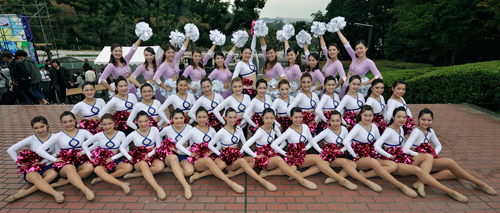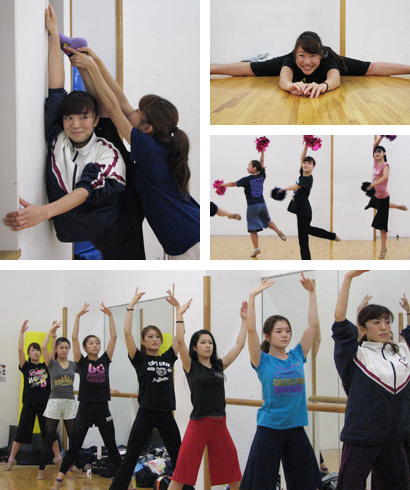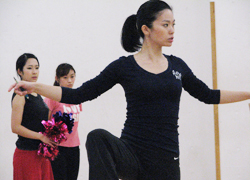Top>HAKUMON Chuo [2013 Winter Issue]>[Feature article] Hakumon Festival: All for 2 min. and 6 sec.
 Index
Index
[Feature article] Hakumon Festival
All for 2 min. and 6 sec.
Chuo University Song Leading Club
Daily training to capture 2nd victory in POM section of All Japan Cheer Dance Championship

Competition rules:
In principle, the cheerleading area is defined as 20 meters wide and 15 meters deep. Competition time is limited to 2 minutes and 30 seconds. Violation results in a two-point deduction from the team’s score. Cheerleading teams are composed of 5 to 30 members. Evaluation is based on a 100-point scale.
Cheerleading competition features teams of 20 members who express dynamic beauty through their smiles. Teams are judged based on their uniformity and sense of unity. Last year, the Chuo University Song Leading Club won first place at the POM section of the All Japan Cheer Dance Championship. Teams at the POM section use pompoms while cheerleading. With an eye on their second consecutive victory, Chuo members prepared for their 2-minute, 6-second performance by training vigorously for 4 days a week and following a strict everyday lifestyle.

Photograph taken to commemorate 6th-place finish at the IASF The Dance Worlds 2013, held in Florida, USA in April-May 2013. (Photograph provided by Chuo University Song Leading Club)
Nicknamed “Garnet Girls,” the Chuo University Song Leading Club is a gathering of female students who enjoy cheerleading. Garnet is the birthstone for January, a tribute to their mentor, who was born in January.
With their flexible bodies clad in glamorous outfits, the cheerleaders take the stage and show off their bright smiles. They possess well-toned legs like fashion models, and hold pompoms in burgundy, which is the club color.
The audience is astonished by their fouette turns.
The cheerleaders spin on the tiptoes of their right feet while extending both arms horizontally. They also lift their knees to their waists as they twirl. With ponytails spinning, the cheerleaders turn a total of 18 times.

Beautiful turns are performed by assistant leader Emi Okazaki (2nd year, Faculty of Letters), who is also known as the fouette leader, as well as by Sawa Hino (2nd year, Faculty of Economics), assistant leader Risako Kumazawa (2nd year, Faculty of Law), Midori Nomura (2nd year, Faculty of Commerce), Yuka Uesugi (2nd year, Faculty of Law), and Misuzu Koito (2nd year, Faculty of Policy Studies).
Another impressive technique is “the scorpion,” a specialty of Kumazawa and Hino. The cheerleaders lift one of their feet backwards with both hands and press it against the back of their heads, creating the image of a scorpion.
Leader Maiko Nakamura (2nd year, Faculty of Commerce), Shiori Hamura (4th year, Faculty of Policy Studies) and Moe Shiiki (1st year, Faculty of Law) excel at the toe touch, a move in which cheerleaders jump, spread their legs out and touch their toes. Natsumi Oshima (2nd year, Faculty of Law) and Mariko Otsuki (2nd year, Faculty of Law) shine when it comes to the hip-hop move called funk.
The Garnet Girls dance with elegance and dynamism, paying close attention to the position of their fingertips, knees and tiptoes. Through a performance which includes line dancing, they captivate the audience.
Unrivaled popularity

The Garnet Girls attracted about 4,000 spectators at the Hakumon Festival (held at Tama Campus, from Oct. 31 to Nov. 3). The stairs in front of the co-op were overflowing with people, and many spectators leaned over the fence on the pedestrian deck to get a glimpse of the cheerleaders.
During the four days of the Hakumon Festival, the Center Stage featured non-stop performances. Among them, the Garnet Girls won first place in the “Stage/Hall Section,” voted by Chuo students. The votes showed the thrilling impression that the cheerleaders left on the audience of about 4,000 people.
The Garnet Girls won first place at the national competition held in November of last year. Also, from April to May this year, they competed in “The Dance Worlds,” a global competition held in Florida. Representing Japan, the Garnet Girls finished 6th among about 55 competing countries.
After the team finished as runner-up at the national competition of USA (United Spirit Association) held at Makuhari Messe in Chiba City in March, an American judge recommended that they compete in The Dance Worlds. This indicated that the talent of the Garnet Girls was recognized by America, the birthplace of cheerleading.
In September, the Garnet Girls took second place at the international competition, Asian Open Cheerleading Championship, held at the Second Gymnasium of Yoyogi National Stadium in Tokyo. It was a strong second-place earned through intense competition with other 7 teams from countries such as the United States, Russia and Thailand. Today, the Garnet Girls are a world-class team which can perform on a global scale.
On November 30, the team finished in first place during the preliminary round in the Kanto region at the POM section of the All Japan Cheer Dance Championship at Makuhari Messe in Chiba City, at which they won first place last year, and advanced to the finals at the Tokyo Metropolitan Gymnasium on December 7. The Garnet Girls are moving steadily towards their second consecutive national victory.
Pain relief

The odor of salomethyl wafts from the Garnet Girl’s practice area. They care for their aches and pains with anti-inflammatory medication. Some members wear knee supporters. The health staff member Yuka Yoshino (2nd year, Faculty of Commerce) always brings pain relief spray, cold packs, and athletic tapes. Just like athletes in any other sport, hard practice is essential to success in the glamorous world of cheerleading.
Their practice begins with stretching. Standing against a wall, they raise their right legs so that they touch their faces and are parallel with the wall. They can easily perform a straddle split and lie down prone like sumo wrestlers. Watching them stretch makes one ponder the limits of flexibility in the human body. These excessive flexibility exercises seem to go beyond the scope of warm-up exercises, yet they continue them for 30 minutes.
Next, they walk forward step-by-step while alternately raising their right and left legs to the height of their faces. They also incorporate ballet exercises into their practice, standing still on their tiptoes for a count of about 10 seconds. Then, staying in the tip-toe position, they bend their knees.
Practice continues for about 90 minutes to complete all exercises, including high knee jumps and turns. Finally, it is time for them to grab their pompoms. They jump with pompoms in their hands, working to align the height of their jumps throughout the team. They also practice strongly beating their pompoms in front of their chests in unison, creating a single sound.
During dance practice, senior students give opinions for honing skills and realizing a more beautiful performance. Assistant leader Okazaki turns around to the underclass students watching in the corner, and waves at them to join and listen.
“I have the experience of being a substitute cheerleader,” explains Okazaki. “I started cheerleading when I entered university and could not keep up with the other members. At that time, senior students reached out to me and gave me private lessons before the group practice. When I became a team member, I realized that while there are various roles, my mission is to help junior students and underclass students who are substitute cheerleaders so that they can interact with the team members.”
Dance music, which is indispensable for practice, is played with a CD player. When the same part is practiced repeatedly, the music is replayed many times. A team member standing close to the CD player is responsible for playing the music. When someone turns it on, the other members thank her. “The feeling conveyed by the words ‘thank you’ is very important,” notes Nomura smilingly.
When the cheerleaders share their opinions about the dance formation and choreography, even senior students speak politely. “Try to stay relaxed,” encourages Oshima. “Let’s keep our mind focused on the next step.”
“I like how the club is not overly concerned with rules and formalities,” says coach and mentor Mari Murata. “Everyone is enthusiastic and they get along really well.”
Finding practice sites

During water breaks, they run to the vending machines and hurry back from restrooms without being instructed to do so. Each member is focused on getting the most out of their valuable practice time.
On some days, the team can use a wooden-floored hall with a large mirror in C Square on the Chuo University Tama Campus for no charge. However, the groups that can use this hall are chosen by lot. When their luck is bad, the team searches for civic centers and other public facilities near the university.
Would-be users must apply 2 months prior to the date of use. Reservations are made by telephone and usage fees are then paid at the reception desk of the facility. If the cheerleading club cannot use their preferred site, they search for another. They keep searching until they find practice sites.
There are 4 club members in charge of booking practice sites: Saki Ueno (2nd year, Faculty of Economics), Seika Kokubun (2nd year, Faculty of Letters), Misuzu Koito (2nd year, Faculty of Policy Studies), and Nozomi Fukase (2nd year, Faculty of Law).
They must limit their search to facilities which can be reached using students’ commutation tickets. Securing practice sites in advance is quite difficult. Leader Nakamura’s schedule book is filled with smudges from writing and erasing her plans, showing how she struggles to find practice sites.
Normally, it costs 3,600 yen to borrow a site for 4 hours. The monthly club membership fee of 4,000 yen is used to subsidize payments. After working hard to search for practice sites, the team does not waste a moment of their time.
Due to such conditions, practice hours vary widely. Practice space also varies among facilities. Club members check whether full-length mirrors are installed at facilities and whether there is sufficient space to replicate the specified competition area. They sometimes use their tapes to mark the specified length and depth.
On some days, practice starts after 9:00 am. On other days, it starts at 5:30 pm and ends at 9:30pm. Some club members moonlight at fast-food shops in order to earn money for paying the club membership fee. They are forced to work during the nighttime after practice because irregular practice hours prevent working regularly.
So hungry…

Even when feeling hunger pangs, club members refrain from eating late at night for fear of interfering with the next day’s practice. “I eat a hearty breakfast and do not eat at night,” says Kokubun. “In the evening before practice, I only have salad and pork miso soup at a cafeteria.” Many of the members eat only salad or bean curd at most. Some members failed to control their weight due to youthful indiscretion.
“I gained weight because I used to eat fried chicken and Chinese noodles after evening practices,” says one member. “Although my weight was appropriate for my height, I was told that I was too heavy for cheerleading. I even gave up eating potato chips.”
Usually, club members eat meat, fish, rice and other foods which provide energy. “I carefully selected dishes such as hijiki, simmered dried-sliced Japanese radish, and beans,” says one member who lived alone when discussing her strict diet. Club members worry about the surprise weight checks.
Appropriate weight is calculated by subtracting 110 (or 115) from height in centimeters. “Being overly-thin is problematic,” warns coach Murata. Some members who dieted excessively have the bitter experience of feeling dizzy during practice.
Even first-year students pay careful attention to their health. “I sometimes feel drowsy after school, practice, and my part-time job,” says Kyoko Takasuga (1st year, Faculty of Policy Studies). “However, no matter how tired I am, I always take a bath and warm my body from the core. Otherwise, I will be unable to put full effort into practice.”
Increasing level of cheerleading technique

Coach Murata gives instruction.
“The number of cheerleaders has increased over the past 5 or 10 years,” explains coach Murata. “Dance technique has improved and the current level is quite high.” 27 students from Chuo University struggle to participate in this fiercely competitive field.
The team uses video recordings to check the entire performance and individual positions. The videos are shared among members. Each member replays her dance with a smartphone, allowing them to rehearse even when riding the train to university.
There are countless things for club members to do: attending classes, writing reports, taking seminars, stretching, learning dance, practicing repeatedly, securing practice sites, having meals, health control, and part-time work. “I lead a fulfilling life,” says Ueno bashfully.
Members lead strict daily lives to prepare for practice. During practice, they constantly try to surpass their last performance. They respect the unity of the team and enhance the power of the team.
After practice, the cheerleaders fight to control their appetites. They sometimes envy the freedom of female students who do not belong to any club. From time to time, club members even feel like crying at night. However, when they complete a cheerleading performance together and see the thrilled faces of the audience, members are filled with a deep sense of accomplishment and fulfillment.
Such delight can only be achieved through teamwork, not individual performance. One for all, all for one. They are all proud of being a member of the Garnet Girls.
-
Reasons for joining the club
“After I was admitted to the university, I was looking at its website and was attracted by the Song Leading Club,” recalls Fukase. “When I went to a restaurant after becoming a university student, senior students of the club were having a meeting. I told them that I was interested in the club and would like to see them practice. Then, I decided to join the club.” (Fukase)
“When I was a high school student, I went to the Hakumon Festival and was mesmerized by the glamour of the cheerleading performance,” explains Okazaki. “Although I was a beginner, I followed my feelings and joined the club.” (Okazaki)
Many members started cheerleading in high school. Chuo University Senior High School also has a song leading club. Coach Murata also gives lessons at the high school, which won first place at the High School Small-Team POM section of the Kanto Tournament preliminary round for the All Japan Cheer Dance Championship held at Makuhari Messe on November 30, and then advanced to the national championship on December 7. The high school also passed the large-team section of the preliminary round, advancing to the national championship.
| Chuo University Song Leading Club | |
|---|---|
| Maiko Nakamura | 2nd year student in the Faculty of Commerce (Leader) |
| Emi Okazaki | 2nd year student in the Faculty of Letters (Assistant leader) |
| Risako Kumazawa | 2nd year student in the Faculty of Law (Assistant leader) |
| Shiori Hamura | 4th year student in the Faculty of Policy Studies (Former leader) |
| Yuka Uesugi | 2nd year student in the Faculty of Law (Acoustic) |
| Saki Ueno | 2nd year student in the Faculty of Economics (Gymnasium) |
| Natsumi Oshima | 2nd year student in the Faculty of Law (Accounting) |
| Mariko Otsuki | 2nd year student in the Faculty of Law (Costumes) |
| Misuzu Koito | 2nd year student in the Faculty of Policy Studies (C Square) |
| Seika Kokubun | 2nd year student in the Faculty of Letters (Gymnasium) |
| Midori Nomura | 2nd year student in the Faculty of Commerce (Costumes) |
| Sawa Hino | 2nd year student in the Faculty of Economics (Video) |
| Nozomi Fukase | 2nd year student in the Faculty of Law (C Square) |
| Yuka Yoshino | 2nd year student in the Faculty of Commerce (Health) |
| Mikako Usui | 1st year student in the Faculty of Economics |
| Hanaka Okayama | 1st year student in the Faculty of Economics |
| Reika Kobayashi | 1st year student in the Faculty of Policy Studies |
| Rina Kan | 1st year student in the Faculty of Commerce |
| Moe Shiiki | 1st year student in the Faculty of Law |
| Rikako Shinohara | 1st year student in the Faculty of Economics |
| Misa Niizawa | 1st year student in the Faculty of Policy Studies |
| Kyoko Takasuga | 1st year student in the Faculty of Policy Studies |
| Ayumi Bashou | 1st year student in the Faculty of Commerce |
| Natsumi Hosokawa | 1st year student in the Faculty of Policy Studies |
| Ikumi Maejima | 1st year student in the Faculty of Commerce |
| Ayana Yamazaki | 1st year student in the Faculty of Letters |
| Keiko Watanabe | 1st year student in the Faculty of Economics |
- Research Activities as a Member of Research Fellowship for Young Scientists (DC1), Japan Society for the Promotion of Science (JSPS) Shuma Tsurumi
- Important Factors for Innovation in Payment Services Nobuhiko Sugiura
- Beyond the Concepts of Fellow Citizens and Foreigners— To Achieve SDGs Goal 10 “Reduce Inequality Within and Among Countries” Rika Lee
- Diary of Struggles in Cambodia Fumie Fukuoka
- How Can We Measure Learning Ability?
—Analysis of a Competency Self-Assessment Questionnaire— Yu Saito / Yoko Neha - The Making of the Movie Kirakira Megane








